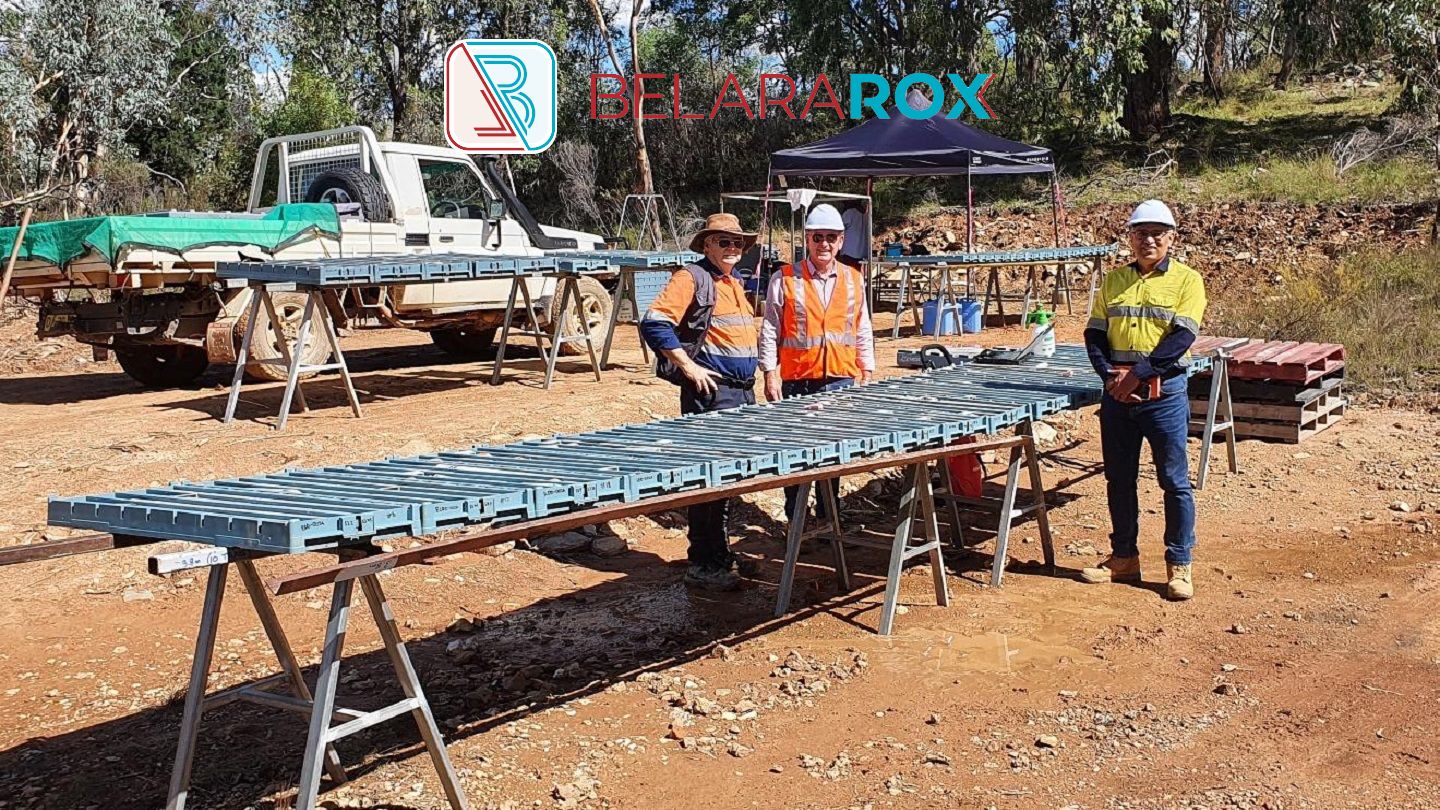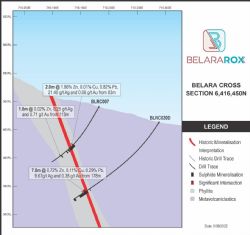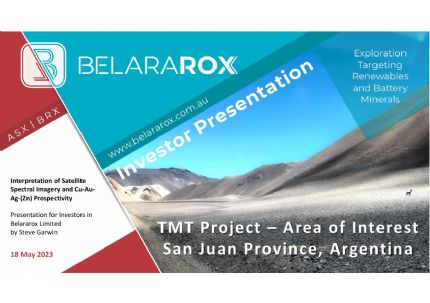 Belara High Grade Mineralisation
Belara High Grade Mineralisation
Perth, Sep 12, 2022 AEST (ABN Newswire) - Belararox Limited ( ASX:BRX), an advanced mineral explorer focused on high value clean energy metals, is excited to announce the assay results from the Phase One Reverse Circulation (RC) and diamond core resource drilling at the Belara mine. The drilling aims to build upon historic results to determine the potential of the Belara Project to host significant zinc and copper mineralisation.
ASX:BRX), an advanced mineral explorer focused on high value clean energy metals, is excited to announce the assay results from the Phase One Reverse Circulation (RC) and diamond core resource drilling at the Belara mine. The drilling aims to build upon historic results to determine the potential of the Belara Project to host significant zinc and copper mineralisation.
Managing Director, Arvind Misra, commented "We are impressed with the continued high quality assay results received from our Phase 1 drilling campaign. Some of the intersections are significantly wider and higher-grade than targeted, confirming the continuity of the interpreted base metal mineralisation in the historic resource model.
We now look forward to the completion of our maiden resource estimation by October and the next stages of exploration work to potentially extend Belara and Native Bee along strike and at depth."
The Belara and Native Bee mine areas are the first high priority targets for resource drilling (see www.belararox.com.au for project details). A phased approach is being taken to the drilling of the Belara and Native Bee mine targets. Phase One aims to deliver the density of drill assay intersections to support an Inferred Mineral Resource estimate prepared in accordance with the JORC (2012) Code over the known area of mineralisation at the Belara (Figure 1*) and Native Bee (Figure 2*) mines.
A total of 33 drill holes were completed in Phase 1, with new assay results from 14 drill holes received. A summary of significant results is presented in Table 2, and Figure 6 and Figure 7*.
At Belara, new assay results have been received from ten holes of the Phase One resource drilling, namely BLRC004D, BLRC005, BLRC008D, BLRC017B, BLRC019D, BLRC020D, BLRC022, BLRC023, BLRC025 and BLDD029 (all significant intersections are shown in Figure 6 and Table 2*).
BLRC019D and BLRC020D were drilled to confirm the continuation of base metal mineralisation in previously untested areas.
The massive sulphide mineralisation intersected in BLRC019D and BLRC020D comprises:
- BLRC019D - 10.0 m at 3.80% Zn, 0.25% Cu, 1.26% Pb, 46.50 g/t Ag and 0.49 g/t Au from 203.0m, including 5.0m at 4.95% Zn, 0.44% Cu, 1.84% Pb, 75.94 g/t Ag and 0.75 g/t Au
- BLRC020D - 7.0 m at 0.72% Zn, 0.11% Cu, 0.29% Pb, 9.67 g/t Ag and 0.38 g/t Au from 178.0m
BLRC019D intersected significantly wider and higher-grade base metal mineralisation than targeted, confirming the continuity of the interpreted base metal mineralisation in the historic resource model (Figure 3*).
BLRC020D, further to the north from BLRC019D, also intersected a 7m wide zone of base metal mineralisation, confirming the continuity of the mineralisation in the historic resource model, and down-dip of BLRC007 (Figure 4*).
Most importantly, results from BLRC019D and BLRC020D confirm high-grade mineralisation is both open down-dip and along strike to the north of the previously identified mineralisation (Figure 6*).
At Native Bee, new assay results have been received from four holes of Phase One resource drilling, namely NBRC003, NBRC004, NBRC005 and NBRC006 (Figure 7 and Table 1*).
The massive sulphide intersections in NBRC003 and NBRC004 are close to the predicted location of the mineralisation in the historic resource model, confirming the continuity and geological interpretation of the geometry of the mineralisation. However, both new intersections contain less combined zinc, copper, lead, silver and gold mineralisation than previously predicted by the historic resource model (Figures 2, 7 and Table 2*). NBRC005 and NBRC006 have returned no significant intersections and indicate the mineralisation is possibly pinching out along strike to the north.
However, the width and total metal content of the mineralisation in NBRC002 is significantly better than the interpreted mineralisation in the historic model (ASX announcement 15th August 2022). This suggests that mineralisation is improving in width and grade at depth and southwards towards the old Native Bee mine workings, located some 400m along strike from NBRC002, and which have not been drill tested to date.
Further, the new assay results confirm the spatial association of higher-grade zinc, copper, lead, silver and gold mineralisation with both the gravity and electrical geophysical anomalies announced on 30 March and 23 March 2022.
There is also further potential to extend the known mineralisation intersected in NBRC001 and NBRC002 a further 2,000m to the south based on the geophysical anomalies and prospectivity mapping results. This area will also be drill tested by the planned Phase Two drilling programme in conjunction with DHEM and FLEM survey data to better understand the size and geometry of any mineralisation intersected.
The results for all the new holes assayed have been entered into the drill hole database and quality control reviews have been completed. All check samples, blanks, and sample weights have been reviewed as part of an ongoing quality control process and returned results within accepted expected statistical ranges, which confirm the validity of the assay results.
All significant intercepts for new holes and previously reported holes are summarised in Table 2, Figure 6 and Figure 7*.
Resource RC Drilling Update
Phase One resource drilling has been successfully concluded at Belara and Native Bee. A total of 38 holes for 5,871 m have been drilled, with 5 holes abandoned, compared to the Phase One resource drill plan of 29 holes for 4,906m (Figure 1, Figure 2, and Table 1*).
Next Steps
A total of 3,728 samples have been sent to the laboratory in Orange since the drilling started at Belara, with 571 assay results pending. These results should be available in the coming weeks.
Acquisition of DHEM and FLEM survey data has been completed, with preliminary 3D appraisal of the data to be completed with supporting drilling data as inputs. This technique could prove a viable method to map in 3D, potential strike and depth extensions at both Belara and Native Bee.
If successful, this technique will provide a valuable tool to quickly and cost effectively test those targets mapped by the prospectivity modelling (refer to ASX announcement of 31 May 2022) and provide more accurate 3D targets for the planned Phase Two drill planning.
The initial metallurgical flotation test work was completed, with encouraging preliminary results confirming the zinc, copper, and lead bearing sulphide minerals can be recovered using flotation.
The recovered concentrates are being assayed and follow up test work will be planned once the preliminary metal recoveries are understood.
All laboratory assay testing and metallurgical test work is on track to support the completion of a Mineral Resource Estimate and supporting Competent Persons Report through October.
*To view tables and figures, please visit:
https://abnnewswire.net/lnk/J55R7X2E
About Belararox Limited
 Belararox Limited (ASX:BRX) is a mineral explorer focused on securing and developing resources to meet the surge in demand from the technology, battery and renewable energy markets. Our projects currently include the potential for zinc, copper, gold, silver, nickel and lead resources.
Belararox Limited (ASX:BRX) is a mineral explorer focused on securing and developing resources to meet the surge in demand from the technology, battery and renewable energy markets. Our projects currently include the potential for zinc, copper, gold, silver, nickel and lead resources.

![abnnewswire.com]()
Related Companies
Social Media
Share this Article

 ASX:BRX), an advanced mineral explorer focused on high value clean energy metals, is excited to announce the assay results from the Phase One Reverse Circulation (RC) and diamond core resource drilling at the Belara mine. The drilling aims to build upon historic results to determine the potential of the Belara Project to host significant zinc and copper mineralisation.
ASX:BRX), an advanced mineral explorer focused on high value clean energy metals, is excited to announce the assay results from the Phase One Reverse Circulation (RC) and diamond core resource drilling at the Belara mine. The drilling aims to build upon historic results to determine the potential of the Belara Project to host significant zinc and copper mineralisation.  Belararox Limited (ASX:BRX) is a mineral explorer focused on securing and developing resources to meet the surge in demand from the technology, battery and renewable energy markets. Our projects currently include the potential for zinc, copper, gold, silver, nickel and lead resources.
Belararox Limited (ASX:BRX) is a mineral explorer focused on securing and developing resources to meet the surge in demand from the technology, battery and renewable energy markets. Our projects currently include the potential for zinc, copper, gold, silver, nickel and lead resources.







